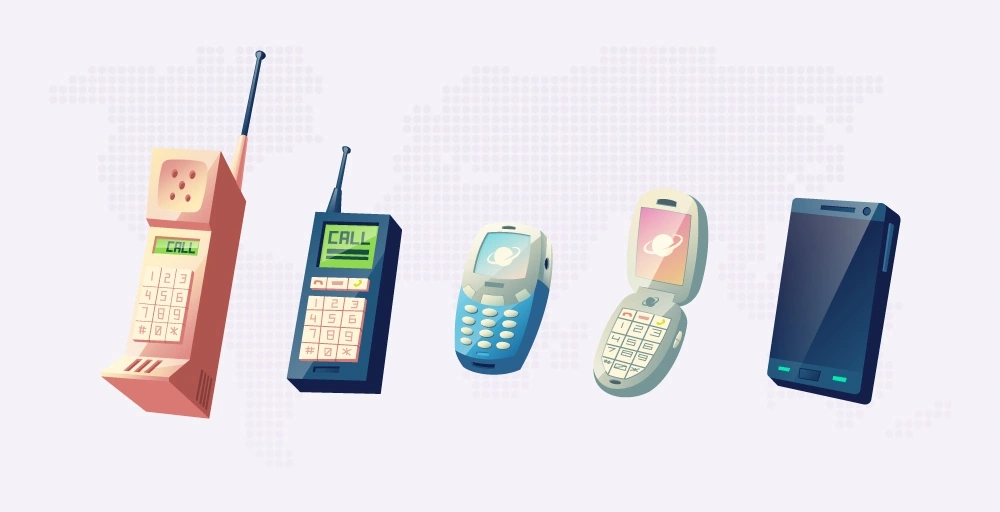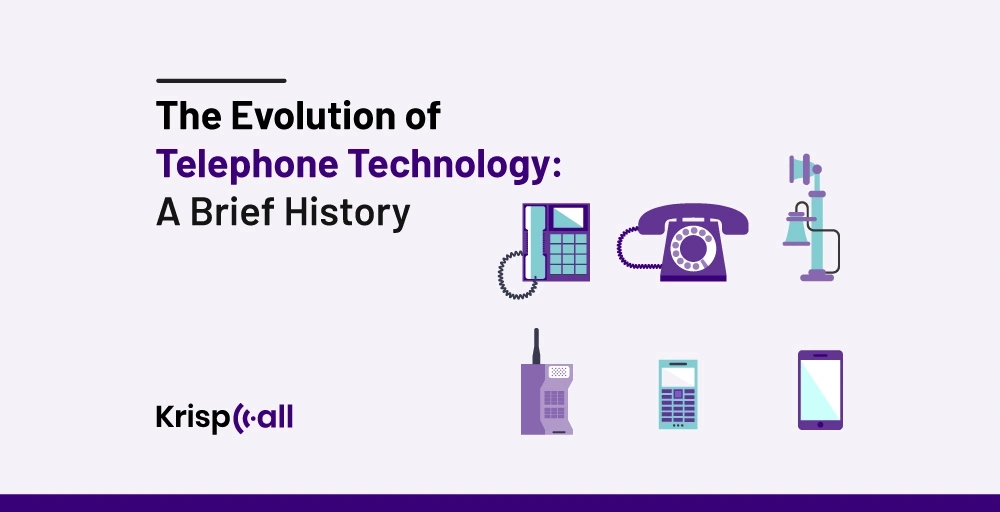The development of telephone technology has been just short of amazing, encompassing from the time when placing a call required going through a switchboard operator to the present day of right away, worldwide communication via smartphones.
Have you ever considered the transition from the first, crude cell phones to the sophisticated gadgets we utilize today?
By exploring the history of telephone technology, you will learn a deeper appreciation for the everyday convenience of modern communication.
Learn about the key milestones, from the invention of the first telephone to the rise of mobile phones and beyond.
What is the History of Telephone Technology?
The evolution of telephone technology dates back to advancements and innovations in the 1960s. Communication was greatly aided by the printing press until the invention of the telegraph. For a very long time, printing was the primary method of communicating with many people.
The development of the rotary dial in the early 20th century made direct dialing possible, eliminating the need for operators.
During the early 20th century rotary dial phones were introduced that enabled direct dialing without operator assistance. The invention of the transistor revolutionized telephony, allowing for more reliable and compact devices.
The 1960s and 1970s marked the advent of digital technology. This technology significantly improved network capacity and call quality. Mobile phones began to appear in the late 20th century. The telephone industry has developed into an advanced network of digital, mobile, and Internet-based communication tools nowadays.
Who Invented The Telephone?
It has been proven that Alexander Graham Bell invented the telephone. He was granted the first patent in 1876 for his invention, which he called a “telegraphy improvement.” With the ability to send sound over great distances, this technology completely changed communication by enabling voice discussions to take place between two distant locations.
The way Bell’s telephone operated was that sound waves were transformed into electrical signals, which were then sent via wires to a device that received the signals and turned them back into sound. This technological discovery was a major step forward for telecommunications and established the groundwork for the contemporary phone networks in use today.
Precursors to the Telephone
Before the invention of the telephone, people communicated across distances using a variety of techniques. Screaming, drumming, and speaking tubes were among them. Mechanical communication devices were attempted to be created in the 17th and 18th centuries, while ideas about using electrical impulses to transfer sound were inspired by the discovery of electricity in the 18th century.
Inventors like Elisha Gray and Alexander Graham Bell created devices that could transmit speech electrically in the late 1800s. Bell is recognized for having obtained the telephone patent in 1876, the first one to be approved. With his prototype created in the 1850s, Italian inventor Antonio Meucci also made a contribution to the creation of the telephone. These pioneering innovators established the foundation for the development of the telephone, which revolutionized communication.
Evolution of Telephone Technology: The Timeline
1876: Alexander Graham Bell created the first usable telephone. This gadget made it possible for individuals to communicate over great distances with the use of electrical impulses.
1877: Bell Telephone business was known as the first phone business that was founded to offer phone services.
1880s: A growing number of families and companies began to have telephones. Multiple phones could be connected to early telephone exchanges.
1890s: The invention of rotary dial phones allowed customers to dial numbers directly without the help of an operator.
1920s: Advancements in telephone technology led to improved sound quality and more dependable connections.
1940s: Large, mostly utilized by emergency services and companies, mobile telephones were developed.
1960s: Push buttons were used in place of rotary dials on touch-tone phones, which made dialing quicker and simpler.
1980s: The invention of cell phones made it possible for consumers to make wireless calls. These were pricey, huge cell phones in the early days.
1990s: Digital mobile phones proliferated, bringing new capabilities like text messaging and improved call quality.
2000s: The saw the development of smartphones, which combined a phone with a computer to enable users to utilize apps, access the internet, and do a lot more.
2010s: With cutting-edge features like GPS, high-quality cameras, and quick internet access, smartphones got more potent.
How did the landline telephone system develop over time?
The growth of landline telephone technology over time is an interesting example of how communication technology has evolved. The first telephones were invented in the 1800s by visionaries such as Alexander Graham Bell and Elisha Gray. Bell and Elisha Gray also established the first telephone lines and switchboards by the late 1800s. The invention of rotary dial phones and automatic telephone exchanges in the early 1900s represented a major development in the telecommunications network.
The development of touch-tone dialing, wireless phones, and prototype picture-phone systems in the 1970s and 1980s created the way for additional advancements in telephony. Mobile phones became popular in the 1990s; gadgets like the IBM Simon, which combined PDA and phone functions, were regarded as revolutionary.
The major technological advancements in the 19th and early 20th centuries:
One significant technological improvement in the 19th and early 20th centuries was the growth of telephone corporations, such as the Bell Telephone Company. These businesses were significant in the development of communication networks. People could communicate with each other even when they weren’t in the same location because of the telephone lines they constructed and the connections they made.
Modern telecommunications systems are shaped in part by the evolution of large telephone firms such as the Bell Telephone Company. Their discoveries cleared the path for the telephone network’s growth, which in turn led to the creation of the internet, landlines, and other interconnected worldwide communication networks that exist today.
Telephone that carries sound through electrical wires:
On March 10, 1876, Alexander Graham Bell invented the telephone that carries sound through electrical wires and revolutionizes communication. Bell’s first words spoken over the telephone were, “Mr. Watson, come here, I want to see you”.
1. First phone and switchboard:
The first phone line was built in 1877–1878, the first switchboard was made and the first phone exchange was operational in 1877–1878. After three years, we had over 49,000 phones.
2. Carbon Microphone by Thomas Edison:
Thomas Edison invented the carbon microphone in 1879 which produced a strong telephone signal. Carbon microphones deliver a high output signal, making them effective in capturing sound and producing strong audio signals
3. Huge number of telephones by 1900:
Bell’s telephone system had about 600,000 phones by 1900; by 1905, that number had skyrocketed to 2.2 million phones, and by 1910, it had reached 5.8 million phones. The transcontinental telephone line went online in 1915.
4. USA’s first long-distance telephone:
In a formal ceremony in 1915 A.G. Bell in New York City and his former assistant Thomas Augustus Watson in San Francisco, California launched the USA’s first long-distance telephone call from coast to coast.
5. International, long-distance call
In 1927 the first phone call over the Atlantic was made in 1927, from the United States to the United Kingdom.
How Did Mobile Phones Transition from Bulky to Portable Devices?
It’s an amazing story of how big and heavy mobile phones gained way to the modern, portable, thin models. Phones became increasingly compact and efficient over time. As batteries got better, phones became lighter. With every advancement, phones have become more convenient to use and transport with changes in time and demands.
In the 1970s, the first commercially available handheld mobile phone Motorola DynaTAC 8000X looked heavy and big anything you’d want to hold to your ear. It weighed around 2.2 pounds (almost 1 kg) and offered a talk time of just 30 minutes. So how did these bulky beasts evolve into the portable devices we rely on today?
From their heavy origins, mobile phones have changed significantly. They were large and bulky in the 1970s, but they gradually got smaller and more portable. The flip phones of the 1980s were a major advancement, featuring a lockable keypad and screen for security.
Then, in the 2000s, smartphones were introduced, merging computers and phones. These phones have a touchscreen instead of a keyboard. Foldable phones which compress to a smaller size while not in use have been produced recently. Improvements in technology like smaller components and improved batteries have made it possible for phones to continue developing while maintaining their portability.

Several key advancements occurred during this transformation which are :
- Miniaturization: Transistors replaced big vacuum tubes, making circuits smaller and phones lighter.
- Battery technology: Improvements in battery life so that you should not charge it in a short period of time.
- Integrated circuits: Packing more functionality onto a single chip that contributed in the reduction of phone size further.
- Material science: Lighter and stronger materials like composites were incorporated which replaced heavier metals.
These advancements went hand in hand with growing demands for phones that were easy to take anywhere. This combination led to a rapid reduction in the size of mobile phones. By the 1990s, phones like the iconic Nokia 3310 were small enough to fit comfortably in a pocket or purse.
How Did Cellular Phone Technology Evolve?
The way we communicate has changed tremendously as a result of the amazing advancement of cellular phone technology. Significant turning points and breakthroughs have occurred throughout the history of mobile technology, from the creation of the cellular network to the present 5G connectivity age.
The birth of the cellular network
When Nippon Telegraph and Telephone (NTT) introduced the first cellular network in Japan in 1979, it laid an environment for modern mobile communication systems. The cellular network had its beginnings in the 1940s with early automobile phone services.
Cellular technology has evolved from 1G to 5G
From 1G to 5G, cellular technology witnessed a transformation from analog to digital networks. While capacity and security have significantly improved with each generation, 5G offers the fastest data transfer rates and most reliable performance.
1G (First Generation)
1G was the first generation of cellular technology that was introduced in the 1980s. It used analog signals to transmit voice calls but the quality was not very good and it could only handle a limited number of calls at a time.
2G (Second Generation)
2G came along in the early 1990s and used digital signals instead of analog. This improved the call quality and allowed for new features like sending text messages (SMS).
3G (Third Generation)
3G arrived in the early 2000s and brought even faster data speeds. This allowed people to access the internet on their phones to send multimedia messages and make video calls.
4G (Fourth Generation)
4G, introduced in the late 2000s, was a big step up. It provided much faster data speeds and lower delays that made it possible to stream high-definition videos, play online games, and use other data-heavy apps on your phone.
5G (Fifth Generation)
5G is the latest and greatest cellular technology launched in 2019. It offers incredibly fast data speeds, very low delays and can handle a huge number of devices at once. This makes it perfect for new technologies like the Internet of Things (IoT), augmented reality (AR), virtual reality (VR), and streaming ultra-high-definition videos.
How Has Mobile Technology Advanced?
With major advancements in mobile operating systems, hardware, and the app economy, mobile technology has come a long way over the years. With the development of mobile operating systems like iOS and Android, smartphones have become incredibly flexible gadgets with a wealth of functions and user-friendly interfaces.
Additionally, improvements in mobile technology which includes processors, cameras, and sensors have raised the bar for smartphone performance. This allows for increased processing speeds, better picture quality, and extended sensor functionality for a range of uses.
Moreover, by offering a wide variety of applications to meet various needs, from productivity tools to entertainment options, the app economy has significantly shaped phone functionality and usage, impacting how users interact with their devices and improving the overall mobile experience.
The emergence of cloud-based telephony is another notable development in mobile technology. Voice over Internet Protocol (VoIP), another name for cloud-based telephony, enables users to place and receive calls online instead of landline phones.
Conclusion
The development of telephone technology, from the earliest switchboard-operated calls to the most advanced smartphones of today, demonstrates remarkable advances in communication. Significant turning points in the history of this industry include Alexander Graham Bell’s creation of the telephone in 1876, the growth of cell phones in the 1980s, and the release of smartphones in the 2000s.
The shift from large, heavy mobile phones to small, lightweight gadgets, fueled by advancements in integrated circuits, battery technology, and miniaturization, has greatly improved our capacity to connect easily and quickly with people anywhere in the world.





